This authentic yaki udon is an easy, budget-friendly dish that is also quick to make (done in just over 20 minutes!). The key here is to use frozen udon for the perfect bite! Japanese stir fried udon is a fantastic comfort food often found at street markets and restaurants in Japan (and all over the world)!
Love quick and easy noodle recipes? Also try my chicken noodle stir fry, Chinese pork mince noodles and beef noodle stir fry. Alternatively, take a browse of all my noodle recipes!
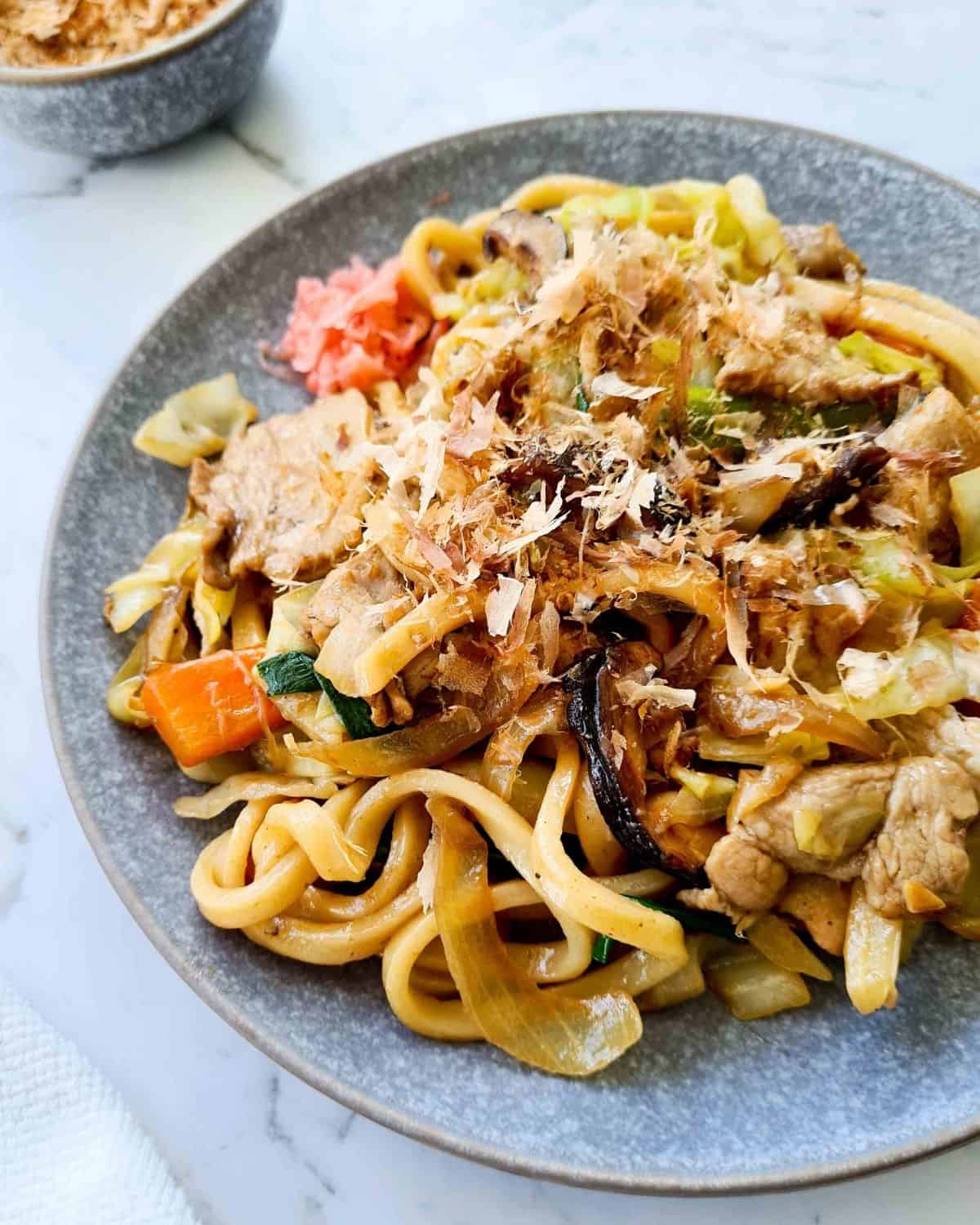
Jump to:
What is yaki udon?
Udon is Japanese thick chewy noodles made of wheat flour that can be added to soups, stir-fries or with a tasty topping. Yaki just means cooked over direct heat so think baked, BBQ, grilled, pan-fried and so on.
Essentially, yaki udon just means stir fried udon noodles and is a very popular street food in Japan. Very quick and easy to make, this stir fried noodle dish is cooked on high heat with inexpensive vegetables and any chosen protein such as pork belly, chicken, beef and even firm tofu.
Very similar to a typical noodle stir fry such as my chicken noodle stir fry with a few notable differences:
- Udon is used instead of Hokkien or other type of noodles. Udon has a delightfully chewy texture whereas Hokkien noodles less chewy and softer.
- Mirin is used instead of shaoxing wine (Chinese rice wine). A bit more on Mirin below.
- Bonito flakes and pickled red ginger are sprinkled and served with the finished dish. These toppings are quintessential to Japanese street food such as okonomiyaki (Japanese savoury pancakes) or takoyaki (Japanese octopus balls).
Ingredients
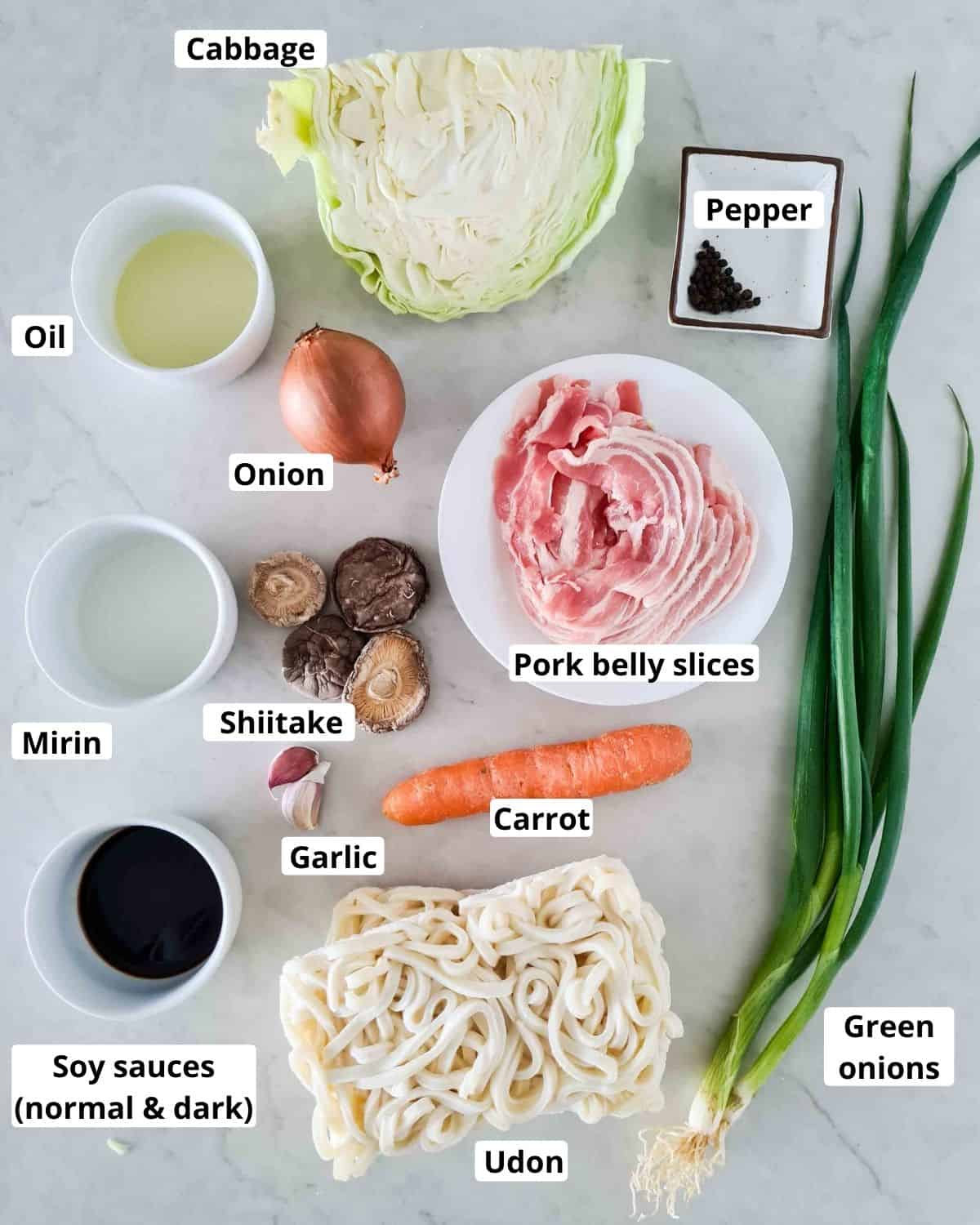
- Udon - (thick, chewy wheat noodles) best use frozen, pre cooked udon noodles instead of those found in the aisles of supermarkets (ie, vacuum sealed ones). Frozen udon has a fantastic chewy texture that the aisle versions lack. They are also longer and stay intacted when stir frying. The vacuum packed udon tend to fall apart super easily. You can find frozen udon at most Asian grocery stores.
- Mirin - widely used Japanese cooking wine that is a little sweet with a slight tang to it. Mirin is one of the few ingredients in the classic Teriyaki Chicken. The alcohol content is much lower than sake (Japanese rice wine used in cooking and consumed as an alcoholic beverage). Substitute: sake, shaoxing wine or dry sherry.
- Shiitake mushrooms - umami powerhouse that adds complexity, flavour and aroma to any dish! Try my Chinese Broccoli (gai lan) and Vegan Dumplings recipes both demonstrating the deliciousness of shiitake mushrooms!
- Dried vs fresh shiitake mushrooms. Both are great, however, high quality dried shiitake mushrooms are much stronger in flavour and thus a pantry staple in many Asian households!
- Dark soy sauce - used together with normal soy sauce. Dark soy sauces are stronger and richer in flavour and colour compared to normal soy sauces. They're also less salty and thus fantastic to use for that extra oomph of umami (savouriness), colour with less salt content. If you can opt for high-quality soy sauces as it makes a HUGE difference. My favourite brands are Wan Ja Shan and Kikkoman (not sponsored).
- Pork belly slices - a popular choice for yaki udon however can use any protein you want.
Cooking step by step
The recipe instructions to making a delicious plate of Japanese stir fried udon is quite straight forward. The key is having all the ingredients prepped and within arms reach before turning the stove on. There is a whole art behind stir frying!
Things move FAST in a stir fry so you want to be prepared for a fuss-free dinner!
Prepare the ingredients
First up, cut and slice the vegetables and chosen protein in similar shapes and sizes. If you're using dried shiitake mushrooms, make sure to allow an extra 15 to 20 minutes of soak time in hot water before slicing.
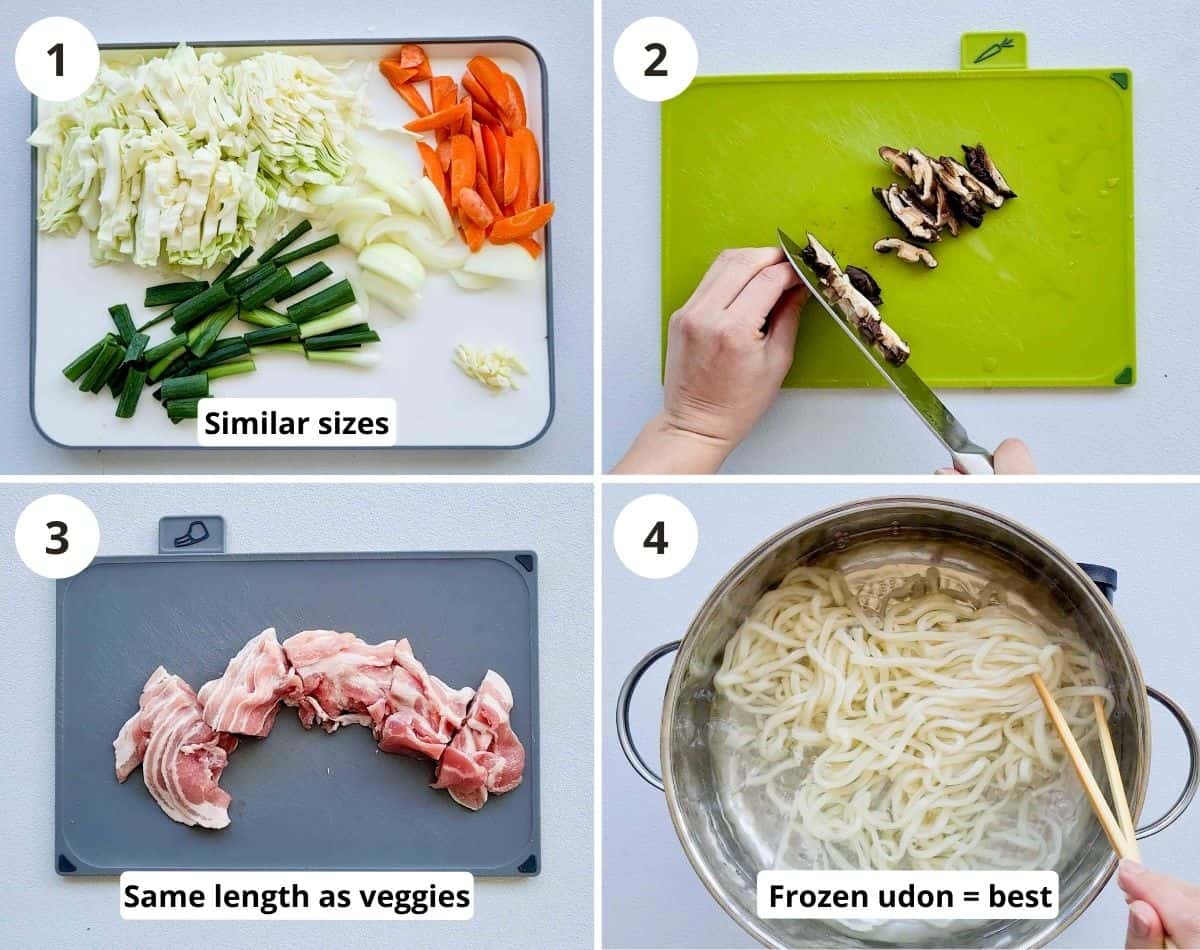
As mentioned under the ingredients section, best use frozen udon noodles. Follow the package instructions to loosen the noodles up, ready for stir-frying. Very simply, put the udon into a pot of boiling water and gently shake apart with chopsticks or a fork then drain.
This step is also much easier when using frozen as opposed to the vacuum sealed ones.
Stir fry
To begin, first, saute the thinly sliced shiitake mushrooms with some vegetable oil to get them lightly golden. This is very important as it transforms the shiitake mushrooms flavour. You'll smell it and it'll be AMAZING.
Then toss in garlic, onions, white parts of green onions and carrots. Cook for a minute or two then add the cabbage. Stir fry over medium heat.
Once the vegetables have softened slightly, make room for your protein by pushing the veg to the rims of the pan. This is what yaki or saute is all about. You want all the ingredients including the pork belly to get direct heat from the pan, getting that caramelisation on. Colour = flavour in cooking.
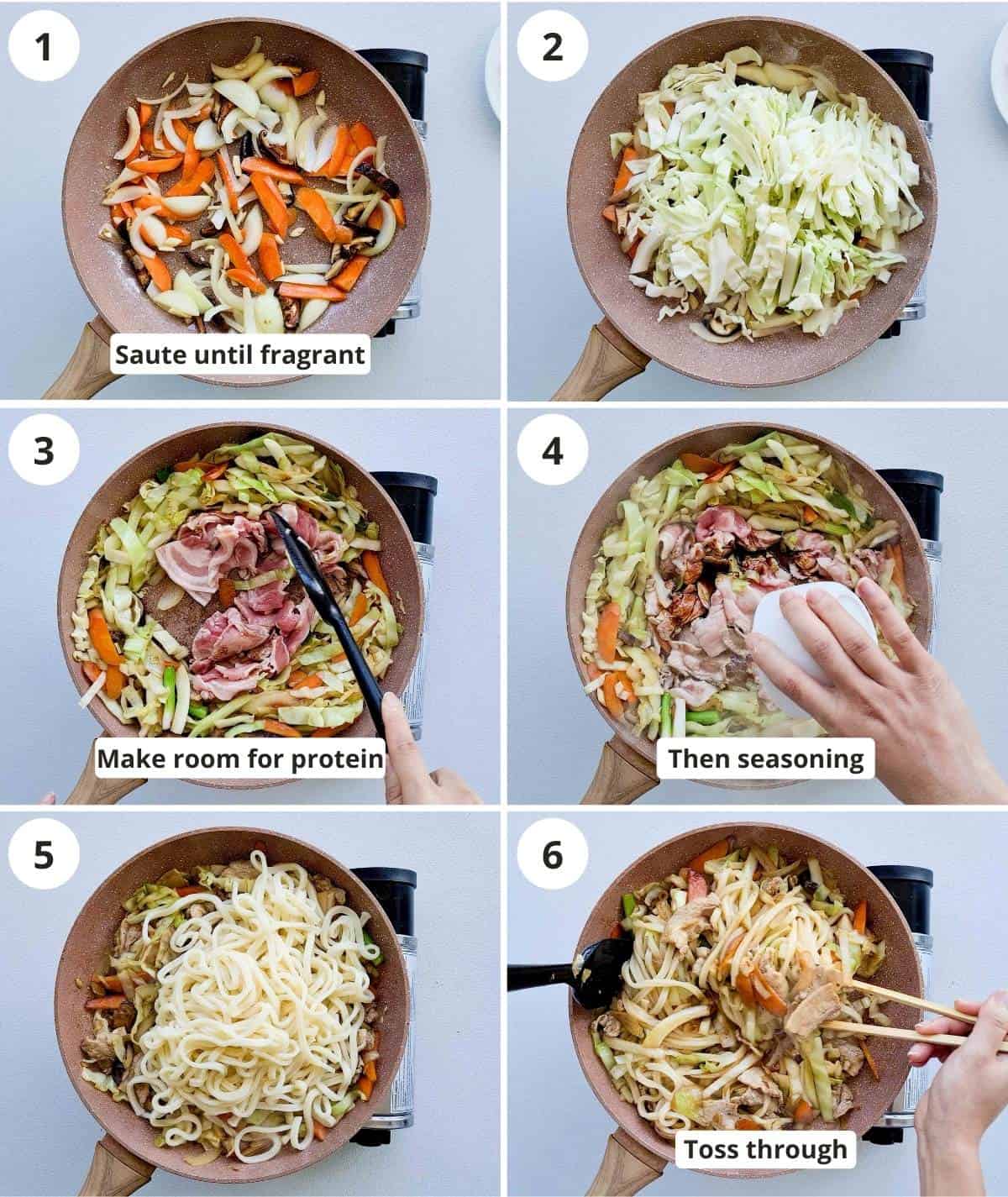
Stir fry the pork belly on high heat then add sauce ingredients (black pepper, dark soy sauce, soy sauce and mirin). After about 1 minute, add the udon noodles and green parts of green onions. Toss everything in the pan over high heat then taste and adjust for seasoning if needed.
Serve with bonito flakes and pickled red ginger (see below image) for the most authentic touch! You can also sprinkle some sesame seeds and drizzle in a little sesame oil over the stir fried udon noodles.
Bonito flakes (katsuobushi) are dried flakes of fermented, smoked then dried ultra-thin flakes of skipjack tuna. They're super light but are massive on the smoked umami flavour and so thin that you'll see them 'dance' when added onto the hot noodles. Bonito flakes really take this udon stir-fry up a notch. I cannot this recommend more!
Pickled red ginger (gari) like those served at sushi restaurants, their main use is to freshen and cleanse your palate (taste buds).
Bonito flakes and pickled ginger can be found at most Asian grocery stores in the Japanese section. I saw both at a Coles (one of Australia's major supermarkets) the other day!
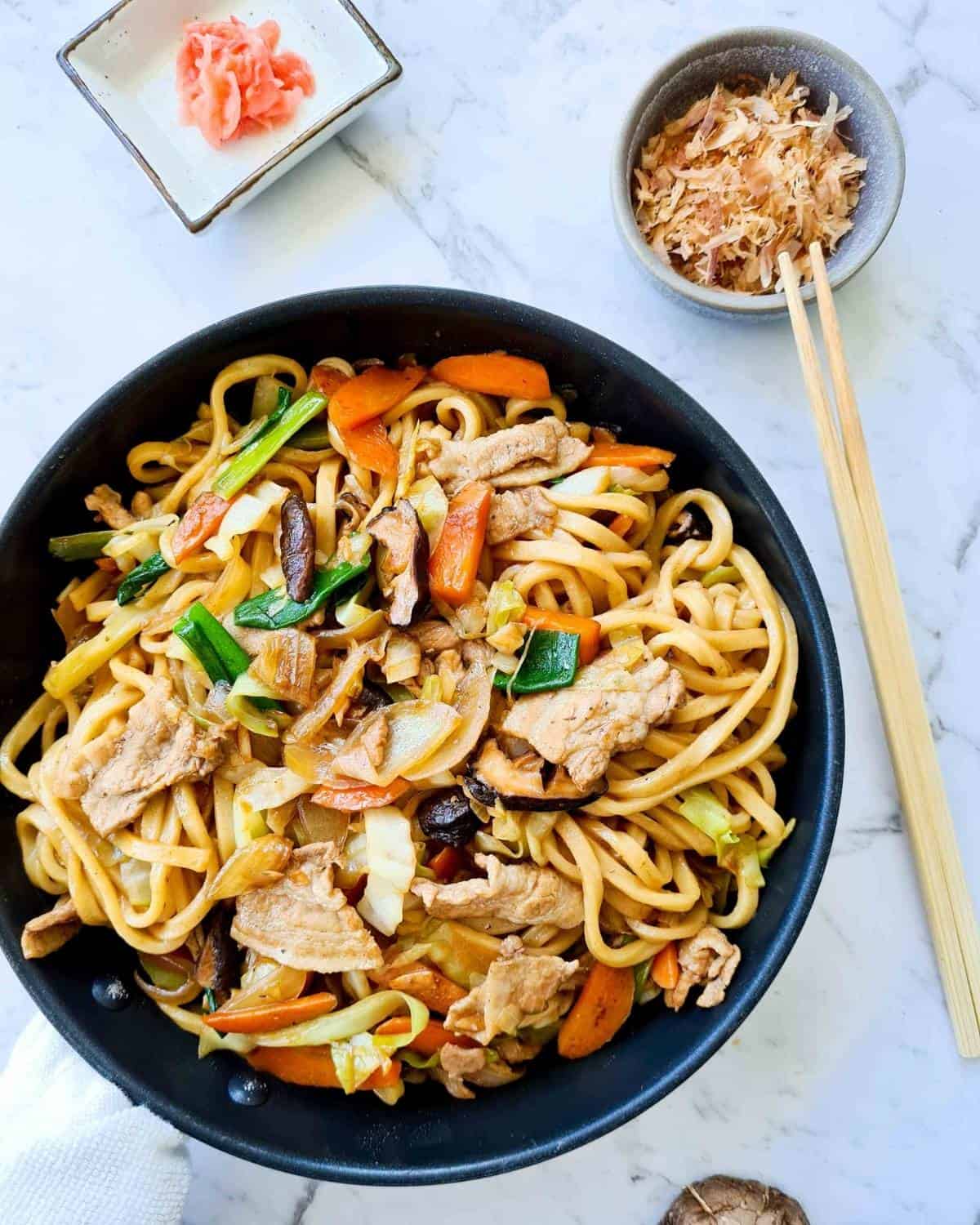
Pro tips for making this perfect every time
- Make room for sizzling the pork belly for maximum flavour. Direct heat from the pan is key to caramelisation! So make sure to use a large enough frying pan or wok.
- Prepare all ingredients and have them all out within arms reach before you begin cooking.
- Use frozen udon. Looks like this is my mantra for making yaki udon!
- Once noodles are added to the pan, toss through using 2 pairs of chopsticks or spatulas (one in each hand) to help with easy mixing and distributing the flavours and ingredients throughout.
- Cut ingredients to similar sizes for even cooking.
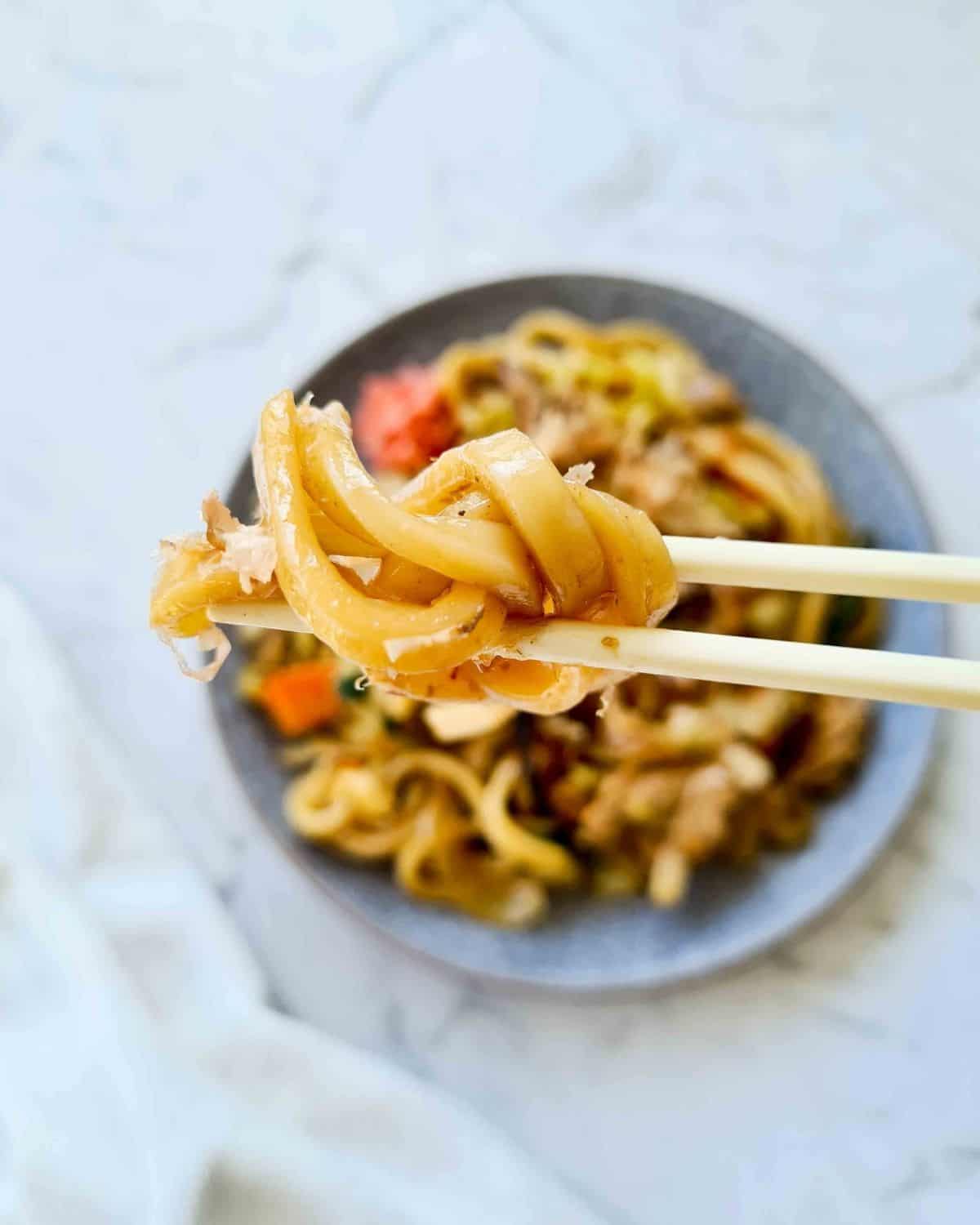
Good to know (FAQs)
Yes! Udon stir fry is packed with lots of vegetables and good amounts of protein and carbs, using mainly whole ingredients. If you are watching your calorie intake, swap the pork belly slices out with lean meats such as chicken or firm tofu. This recipe makes 2 very generous servings or 3 moderate servings.
Any vegetables you can find in your fridge will work great! Leftover limp celery? Add it in. Got some button mushrooms and spinach leaves? Add those in too. This is the beauty of stir-fries. You can add whatever vegetables you like! Just make sure to taste for additional seasoning if adding extra veg.
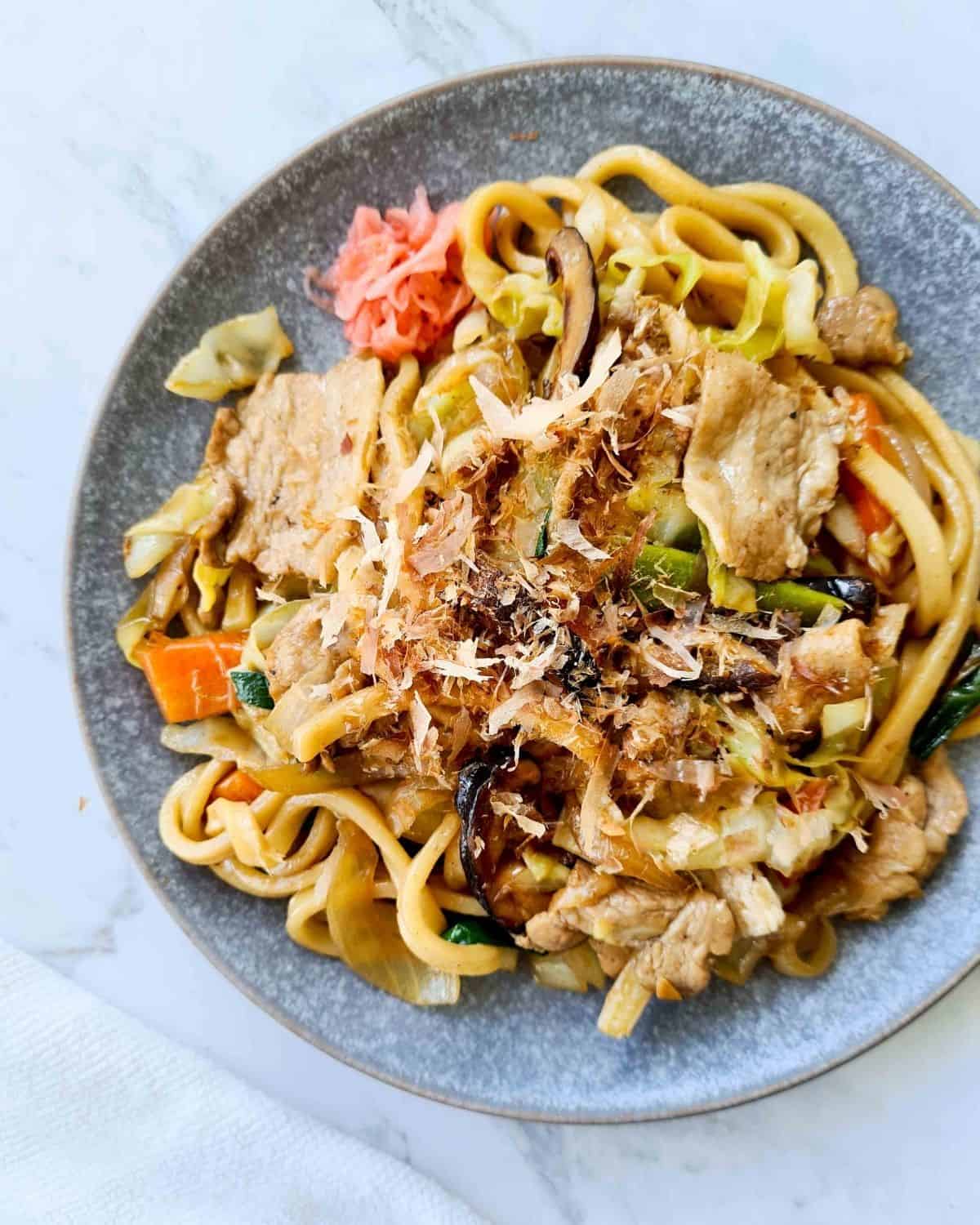
Leftovers/freezing
Any leftovers can be stored for 3 to 4 days in the fridge in an air-tight container and up to 6 months in the freezer. But best not keep for that long in the freezer as they can get freezer burns.
To reheat from frozen, transfer from the freezer to the fridge the night before to defrost. Reheat in a pan or a microwave.
Made this recipe? Let me know your thoughts or questions by dropping a note in the comments section below! I'd love to hear from you 🙂
Happy cooking and eating! - Gen
📖 Recipe
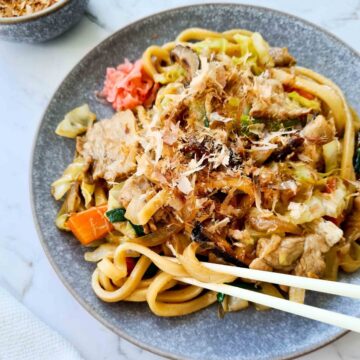
Yaki udon (Japanese stir fried udon noodles)
Ingredients
- 2 servings udon 500g/18oz frozen or fresh (note 1)
- 150 g /5 oz pork belly slices or any protein, eg. chicken, tofu, beef
- 3 cups cabbage finely sliced
- 1 carrot halved lengthways then finely sliced
- 6 shiitake mushrooms sliced, fresh or dried (note 2)
- 1 brown onion finely sliced
- 2 green onions cut to 2inch/5cm long, white and green parts separated
- 2 cloves garlic minced
- 2 tablespoon oil
Seasoning
- 1 tablespoon soy sauce
- 1 tablespoon dark soy sauce (note 3)
- 1 tablespoon mirin substitute: rice wine, dry sherry (note 4)
- black pepper
To serve (optional but recommended)
- bonito flakes (katsuobushi) (note 5)
- Japanese pickled ginger (gari) (note 5)
Instructions
- Prepare udon according to packet instructions.
- Add 1tbsp of oil in a large frying pan or wok on high heat. Add shiitake mushrooms and cook until lightly golden, about 1 minute.
- Add onions, white parts of green onions, garlic and carrots. Stir fry for 1 minute then add cabbage, cook on medium-high heat for 3 to 4 minute or until vegetables soften.
- Push vegetables to the rims of the pan, clearing space in the middle of the pan. Add remaining 1 tablespoon of oil then pork belly. Stir fry the pork belly (without mixing vegetables in) on high heat for about 1 minute then add seasoning. Mix everything through.
- Add udon and toss through with 2 spatulas (or chopsticks), one in each hand to help with even distribution of seasoning and vegetables. About 2 to 3 minutes.
- Serve immediately with bonito flakes and Japanese pickled ginger.


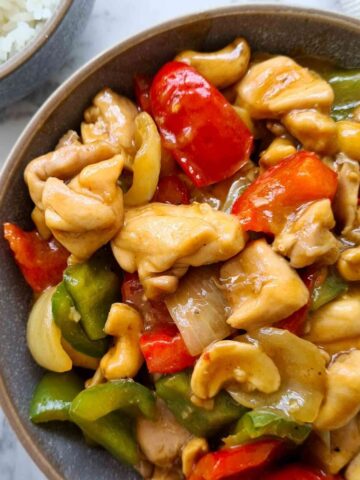
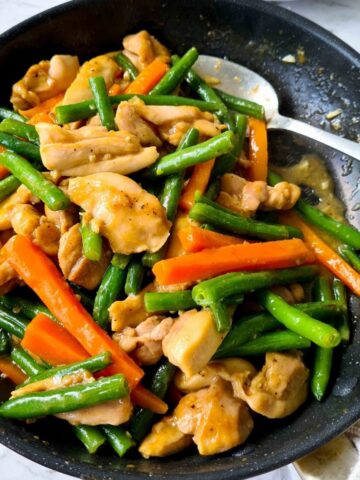

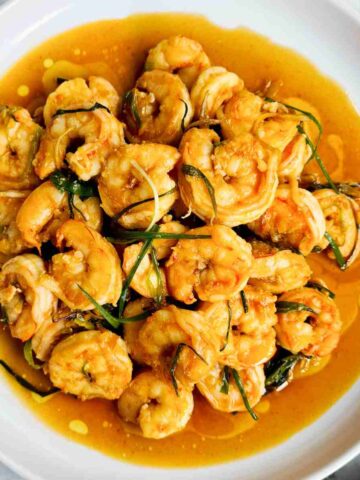
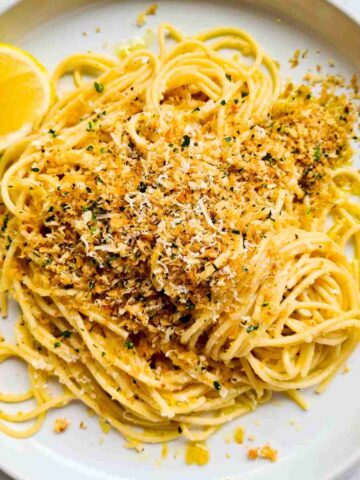
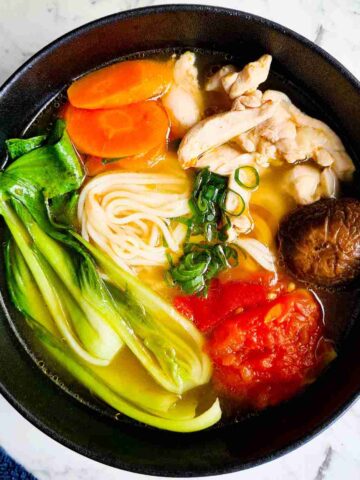

Leave a Reply